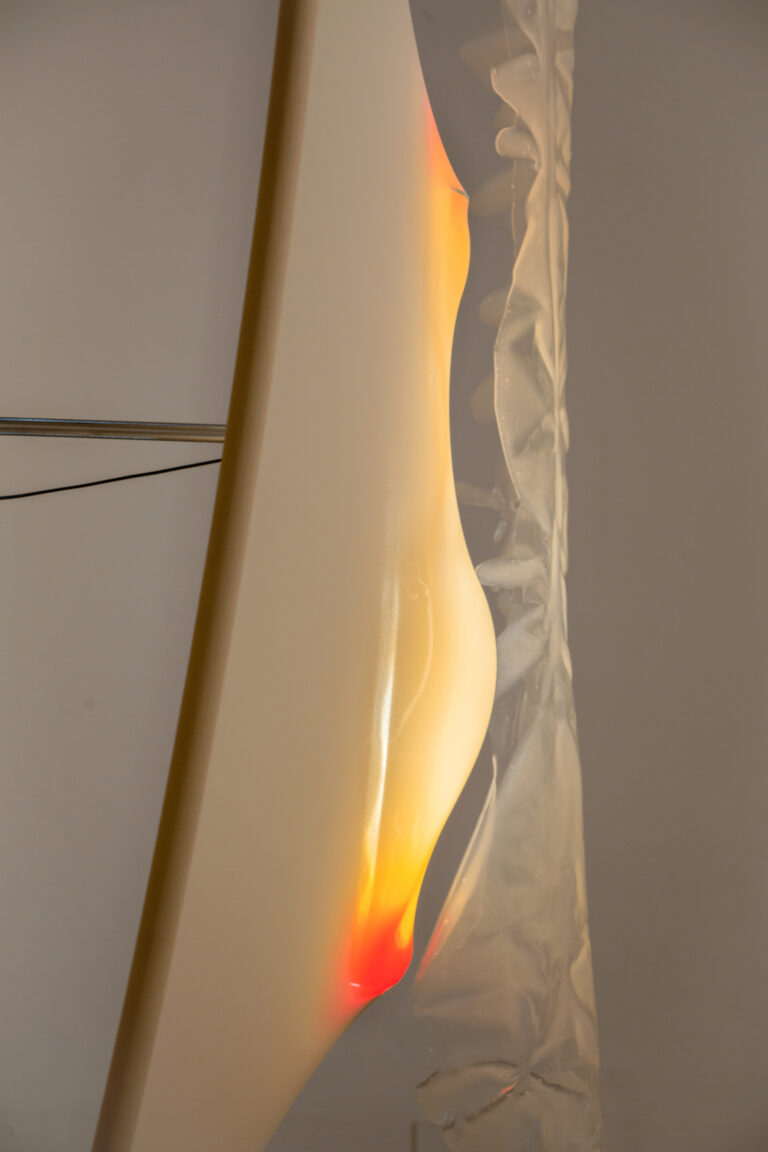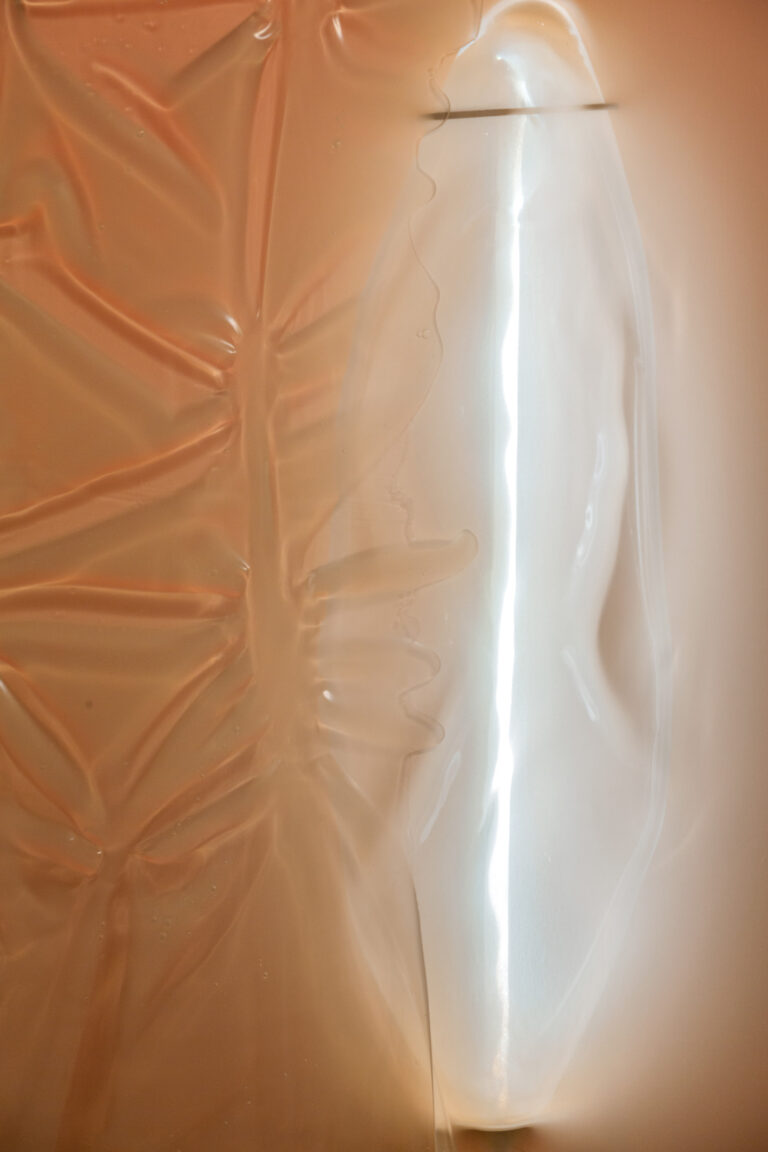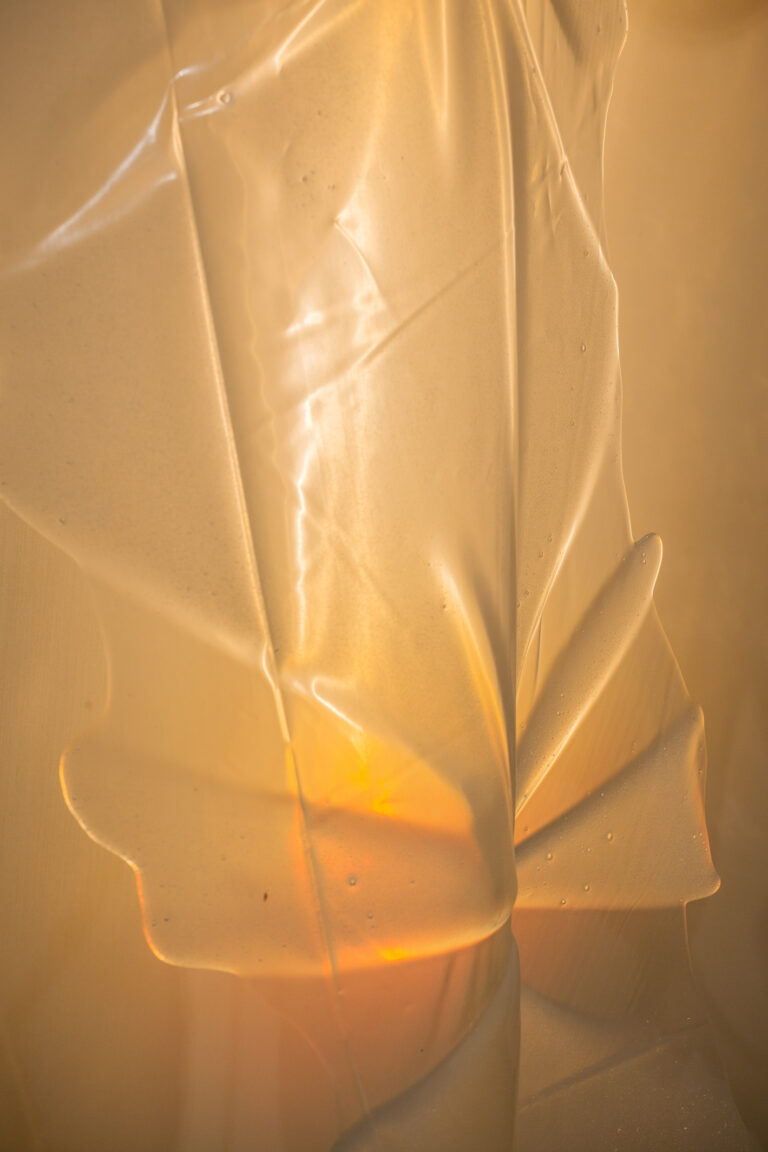Pakui Hardware
Thresholds
carlier | gebauer, Berlin, is pleased to announce Thresholds, Pakui Hardware’s third solo exhibition with the gallery.

Pakui Hardware, Thresholds, 2025 (detail)
Exhibition view at at Zachęta National Gallery of Art, Warsaw, 2025
Photo © Pakui Hardware
The exhibition is financed by the Lithuanian Council for Culture
Neringa Černiauskaitė and Ugnius Gelguda, known as Pakui Hardware, are an artistic duo from Lithuania, who will present new kinetic sculptures. Made of steel, glass, silicone, and elastic fabric, their creations move at a steady pace, creating an impression of autonomous beings.
First shown at Zachęta – National Gallery of Art, Warsaw, Thresholds focuses primarily on the metaphor of the filtering membrane, as well as on biological immunity. Organisms defend themselves by telling foreign objects from their own bodies. By drawing on references to medical imaging, biology and the materiality of the body, the artists explore its limits and vulnerability to outside influence.

Pakui Hardware, Thresholds, 2025 (detail)
Exhibition view at at Zachęta National Gallery of Art, Warsaw, 2025
Photo © Pakui Hardware
The exhibition is financed by the Lithuanian Council for Culture

Pakui Hardware, Thresholds, 2025 (detail)
Exhibition view at at Zachęta National Gallery of Art, Warsaw, 2025
Photo © Pakui Hardware
The exhibition is financed by the Lithuanian Council for Culture
“With these materials, we can bring together themes that otherwise would require straightforward explanation: stainless steel is associated with medicine, silicone – with skin-like prostheses, and laboratory glassware – with scientific experiments. This is how we construct our own visual language.”
– Pakui Hardware
Since 2023, Neringa Černiauskaitė and Ugnius Gelguda have been exploring the concepts of genetics, the nervous system, and the immune system as metaphors for management – both of the individual and of society. Their previous projects, such as THE BURN at carlier | gebauer, Berlin, or Inflammation, presented at the Lithuanian National Museum of Art in Vilnius and then at the 60th Venice Biennale, focused on topics such as illness and treatment. This allowed the artists to make references to regional and global social problems such as the climate crisis, droughts or migration. They believe that the body – both the human body and the body of the planet – remembers its history through genes, molecules or shapes.
The exhibition also enters a dialogue with the work of artists such as Zilia Sánchez Domínguez (1926–2024) or Aleksandra Kasuba (1923–2019), who explored relationships between the body, space, and materiality. The work of Pakui Hardware shows that not only does modern art explore the structure of ecosystems, but it also talks about the systems of control and supervision as well as the complex relations between the individual and society.
Text by Agnieszka Pindera
The exhibition is financed by the Lithuanian Council for Culture.
Maria Taniguchi
11 SEP until 20 DEC 2025
Opening – 11 SEP 2025, 6-10 pm

Maria Taniguchi,
exhibition view at carlier | gebauer, Berlin, 2025
Courtesy of the artists and carlier | gebauer, Berlin/Madrid
Photos © Andrea Rossetti
carlier | gebauer, Berlin, is pleased to announce Maria Taniguchi’s third solo exhibition with the gallery, where she will present her most recent paintings. Initially trained as a sculptor, Taniguchi has created a body of work spanning video as well as sculpture, however her oeuvre is mainly composed by canvases: her signature monochrome “untitled” brick paintings. They occupy the threshold between painting and sculpture, since the artist exhibits her monumentally sized canvases leaning onto the walls of the exhibition space.

Maria Taniguchi
Untitled, 2025 (detail)
acrylic and pencil on canvas
228 x 114 cm
Courtesy of the artist and carlier | gebauer, Berlin/Madrid
Photo © Roman März

Maria Taniguchi,
exhibition view at carlier | gebauer, Berlin, 2025
Courtesy of the artists and carlier | gebauer, Berlin/Madrid
Photos © Andrea Rossetti
Taniguchi’s latest works initially seem to mark a chromatic shift, moving away from the opaqueness of the greyish surface to revealing reddish hues. While these recent paintings appear translucent in contrast to previous ones, they bring to attention how this aspect of transparency was always a part of Taniguchi’s practice. Further, they highlight the subtle alterations within a method the artist has been rigorously employing over the past seventeen years. Taniguchi first creates the base by priming the canvas, then adds the drawing on top. Its graphite lines create the pattern of bricks. Finally, one by one each brick is painted. In this last step, Taniguchi experiments with different pigments, by this way small amounts of colours made their way into the brick grid. These shifts and alterations become apparent upon close observation of individual paintings, especially in constellations of larger groupings.
With her newest pieces, Taniguchi turns her attention to the initial step, by leaving the canvas ungrounded. Through this alteration at the beginning of the process, a quality is accentuated that the works attain with the last step: their transparency, inherent to them since Taniguchi first began this body of work in 2008. The scale of these early canvases was determined by the constraints of her space, the largest being confined by the dimensions of the room used by Taniguchi for painting. Since then, every work has become part of a meticulous structure, expanding a framework exposing its own contingency. Even though the specific conditions Taniguchi sets for each work remain in their core unchanged, within this structure the final result is left to fortuitousness. Almost paradoxically said, Taniguchi creates a method to paint chance into a pattern. This methodology of repetition resembles in its precision the one of a natural scientist, setting up for an experiment, while her disciplined commitment, one could term it as obsessiveness, denotes a meditative, nearly spiritual aspect of her practice. Nonetheless, it is not at all detached from the bodily realm, rather firmly rooted in it, functioning as a manifestation of labour and time poured by Taniguchi into the genesis of the work.

Maria Taniguchi
Untitled, 2017
Acrylic, canvas
275 x 487 cm
Photo © Jussi Tiainen

Maria Taniguchi,
exhibition view at carlier | gebauer, Berlin, 2025
Courtesy of the artists and carlier | gebauer, Berlin/Madrid
Photos © Andrea Rossetti
As a durational act of repetition, her particular approach carries beyond what a body can endure, even further beyond the entity of a single canvas. In regard to Taniguchi’s practice, repetition and structure inform it both as formal principles and the subjects of her work. Each work accumulates to the existing structure, created as a result of a labour and time intensive approach. This process allows transmutations to occur, where labour is transmuted into time. In this respect Taniguchi’s canvases can be described as monuments to time, to the dedication of an artist to their lifework, inviting the viewer to closely observe the elusive patterns in their surface, reflecting her choice of materials as well as the labour consolidated within these works.
